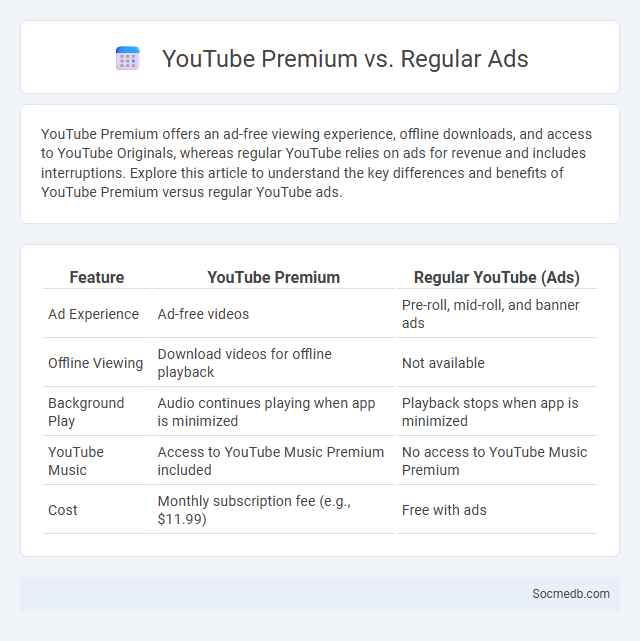
Photo illustration: YouTube Premium vs Regular Ads
YouTube Premium offers an ad-free viewing experience, offline downloads, and access to YouTube Originals, whereas regular YouTube relies on ads for revenue and includes interruptions. Explore this article to understand the key differences and benefits of YouTube Premium versus regular YouTube ads.
Table of Comparison
| Feature | YouTube Premium | Regular YouTube (Ads) |
|---|---|---|
| Ad Experience | Ad-free videos | Pre-roll, mid-roll, and banner ads |
| Offline Viewing | Download videos for offline playback | Not available |
| Background Play | Audio continues playing when app is minimized | Playback stops when app is minimized |
| YouTube Music | Access to YouTube Music Premium included | No access to YouTube Music Premium |
| Cost | Monthly subscription fee (e.g., $11.99) | Free with ads |
Overview of YouTube Premium, Regular Ads, and Demonization
YouTube Premium offers an ad-free experience with exclusive access to original content and offline downloads, enhancing your viewing convenience. Regular ads on YouTube include skippable and non-skippable formats, which can interrupt video playback and affect user engagement. Demonization refers to the process where videos are restricted or demonetized due to content that violates YouTube's advertising guidelines, impacting creators' revenue and visibility.
Key Differences Between YouTube Premium and Regular Ads
YouTube Premium offers an ad-free viewing experience, whereas regular YouTube users encounter ads before and during videos, impacting uninterrupted content consumption. Premium subscribers gain access to exclusive features such as offline downloads and background play, enhancing usability beyond the capabilities of the standard free version. Monetization for creators differs as regular users generate ad revenue, while YouTube Premium revenue is distributed based on watch time from paying subscribers.
What Is Monetization and Demonetization on YouTube?
Monetization on YouTube refers to the process where content creators earn revenue from their videos through ads, channel memberships, Super Chats, and YouTube Premium revenue. Demonetization occurs when YouTube removes or restricts ads on videos due to content that violates its advertiser-friendly guidelines, affecting your potential earnings. Understanding these processes helps you optimize content to maximize revenue while adhering to platform policies.
User Experience: YouTube Premium vs Ad-Supported Content
YouTube Premium enhances your social media experience by offering ad-free videos, background play, and offline downloads, improving overall viewing satisfaction. Ad-supported content on YouTube includes interruptions that can disrupt engagement and reduce content accessibility. Choosing YouTube Premium optimizes user experience by delivering seamless, uninterrupted video streaming tailored to your preferences.
Impact of Ads on Content Creators’ Revenue
Social media advertising significantly influences content creators' revenue by providing diverse monetization opportunities through sponsored posts, brand partnerships, and affiliate marketing. Your earnings can fluctuate based on audience engagement metrics, ad placement, and platform algorithms that determine ad visibility. Effective use of targeted ads not only increases creator income but also shapes content strategies to align with advertiser preferences.
How YouTube Demonization Affects Creators and Channels
YouTube demonetization significantly impacts creators by reducing their revenue streams, often causing financial strain and limiting content production. Channels with fewer monetized videos face decreased visibility and algorithmic disadvantages, hindering growth and audience engagement. This revenue instability forces many creators to diversify income sources or alter content strategies to comply with strict platform policies.
Cost Comparison: YouTube Premium Subscription vs Watching Ads
YouTube Premium subscription offers an ad-free experience for a monthly fee, typically ranging from $11.99 to $15.99, depending on your region and plan. Watching ads on YouTube remains free but can disrupt your viewing with frequent interruptions, potentially affecting productivity and user satisfaction. Your decision between paying for YouTube Premium or tolerating ads should weigh the cost against the value of uninterrupted content consumption.
Ad Types and Frequency for Regular YouTube Users
Regular YouTube users encounter various ad types such as skippable in-stream ads, non-skippable ads, bumper ads, and overlay ads, each designed to engage different viewer preferences without disrupting the video experience excessively. The frequency of ads depends on factors like video length, user behavior, and subscription status, typically ranging from one to three ads per video for non-subscribers. Understanding your ad exposure helps optimize viewing habits and informs decisions on premium subscriptions or ad-blocking solutions.
Content Eligibility and Risks for Demonization
Content eligibility on social media platforms requires strict adherence to community guidelines, including prohibitions on hate speech, violence, and harassment to avoid demonetization. Algorithms and automated moderation systems assess content based on relevance, originality, and compliance with platform policies, leading to potential removal or limited monetization of flagged posts. Creators must navigate nuanced standards that balance freedom of expression with the prevention of harmful or misleading content to maintain monetization privileges.
Which Option Offers the Best Value and Experience?
Choosing the best social media platform for your needs depends on factors like user engagement, advertising options, and content types. For businesses, platforms like Facebook and Instagram offer robust targeting tools and diverse ad formats, maximizing return on investment. Your decision should align with where your audience spends the most time and which platform delivers the richest user experience.
 socmedb.com
socmedb.com